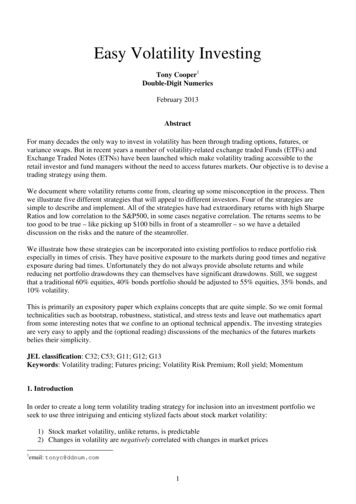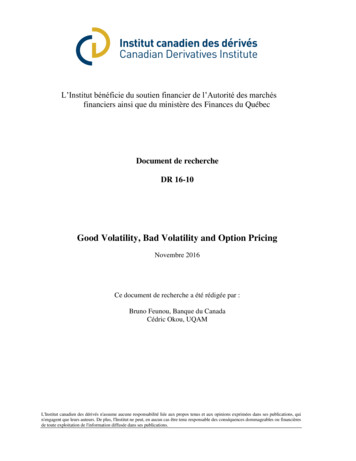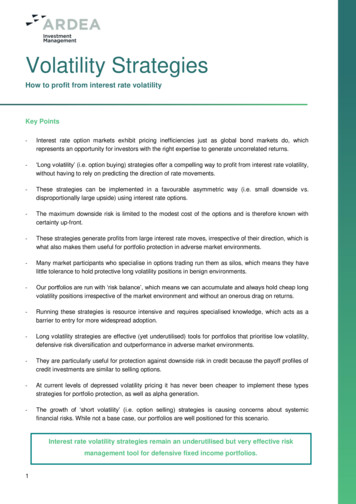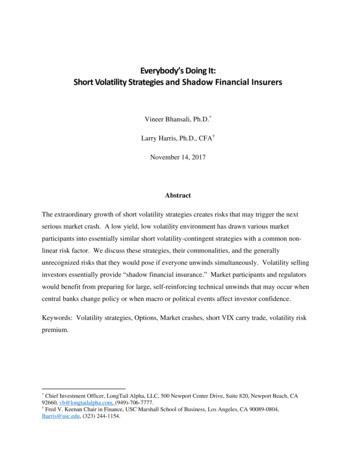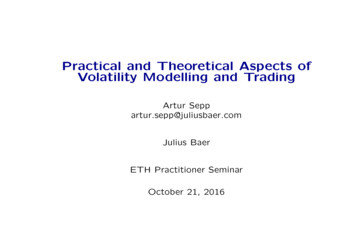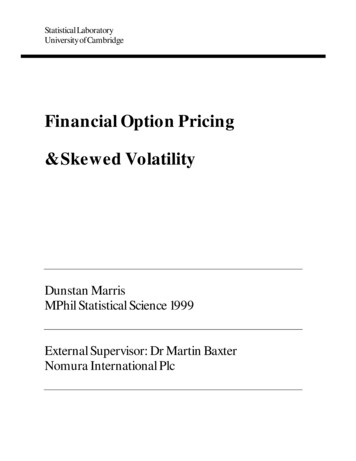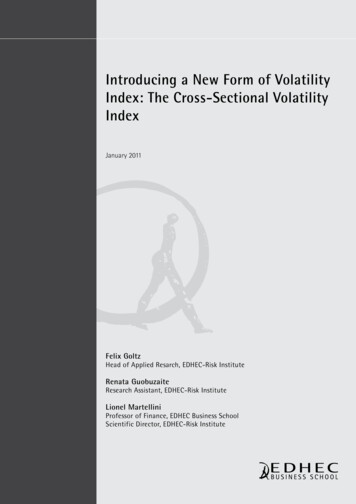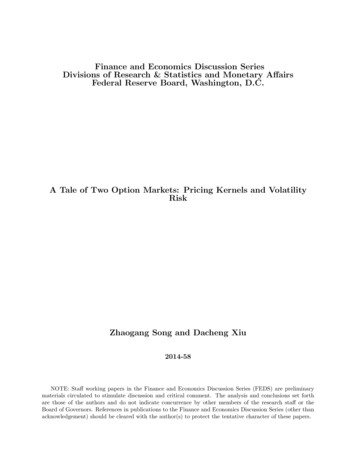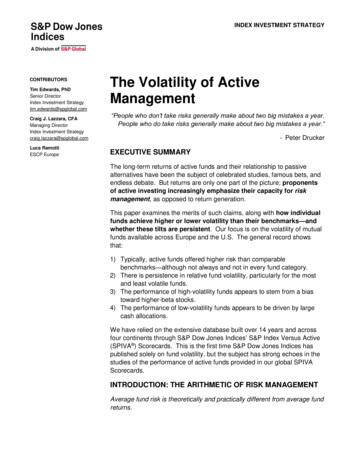
Transcription
INDEX INVESTMENT STRATEGYCONTRIBUTORSTim Edwards, PhDSenior DirectorIndex Investment Strategytim.edwards@spglobal.comCraig J. Lazzara, CFAManaging DirectorIndex Investment Strategycraig.lazzara@spglobal.comLuca RamottiESCP EuropeThe Volatility of ActiveManagement“People who don’t take risks generally make about two big mistakes a year.People who do take risks generally make about two big mistakes a year.”- Peter DruckerEXECUTIVE SUMMARYThe long-term returns of active funds and their relationship to passivealternatives have been the subject of celebrated studies, famous bets, andendless debate. But returns are only one part of the picture; proponentsof active investing increasingly emphasize their capacity for riskmanagement, as opposed to return generation.This paper examines the merits of such claims, along with how individualfunds achieve higher or lower volatility than their benchmarks—andwhether these tilts are persistent. Our focus is on the volatility of mutualfunds available across Europe and the U.S. The general record showsthat:1) Typically, active funds offered higher risk than comparablebenchmarks—although not always and not in every fund category.2) There is persistence in relative fund volatility, particularly for the mostand least volatile funds.3) The performance of high-volatility funds appears to stem from a biastoward higher-beta stocks.4) The performance of low-volatility funds appears to be driven by largecash allocations.We have relied on the extensive database built over 14 years and acrossfour continents through S&P Dow Jones Indices’ S&P Index Versus Active(SPIVA ) Scorecards. This is the first time S&P Dow Jones Indices haspublished solely on fund volatility, but the subject has strong echoes in thestudies of the performance of active funds provided in our global SPIVAScorecards.INTRODUCTION: THE ARITHMETIC OF RISK MANAGEMENTAverage fund risk is theoretically and practically different from average fundreturns.
The Volatility of Active ManagementAugust 2016Since—as is standard—we shall use volatility of returns as an appropriatemeasure of risk, it is important to note the potential for average fundvolatilities to show surprising behavior. The arithmetic of active volatilityis different, so to speak, from the arithmetic of active returns.1In a general sense, volatility is similar to return: the volatility of a group offunds must be reflective of the universe in which those funds operate. Butthis comparison only goes so far, as managers overweight and underweightsecurities within their universe. For every active portfolio that overweightsa certain stock, another active portfolio must be underweight. Thisargument is familiar in the context of active fund returns and usuallyconcludes by observing that the average (capitalization-weighted) fundreturn is expected to match that of the benchmark, minus expenses. Thesame is not true of volatility: it is possible for all active portfolios tobe more volatile, or less volatile, than their composite portfolio (orbenchmark).It is possible for allactive portfolios to bemore volatile, or all tobe less volatile, than thecomposite.Funds may achieve higher volatility simply though higher concentration,which can lead to lower diversification. If all funds are reasonablyconcentrated, then the resultant lack of diversification makes it possible forevery fund to be more volatile than its benchmark, even if the average fundis not biased towards more risky securities.2Conversely, it is a surprising fact that funds can share an average volatilitythat is less than that of their asset-weighted composite—a counterintuitivepossibility given the principle of diversification. Intriguingly, the concept’svery unfamiliarity may be a result of the rarity of persistent outperformanceby active funds. A thought experiment, provided in Appendix A, illustrateshow the persistence of skill might create such a scenario.Of course, both fund return and fund volatility may be subject to variationsthat arise through the ownership of securities outside their statedbenchmark. For example, most funds hold some allocation to cash or cashequivalents for operational purposes, and the amount held will affect bothperformance and volatility, as will, e.g., the propensity for U.S. domesticequity funds to hold some positions in international stocks.3 Excluding cashallocations, to the extent that such out-of-benchmark investing is prevalent,it may be understood as a form of fund category misclassification.1William F. Sharpe describes the average returns for active investors in “The Arithmetic of Active Management,” Financial Analysts Journal,January/February 1991.2The potential impact of higher concentration on active portfolios is examined further in Edwards, Tim and Craig J. Lazzara, “Fooled byConviction,” July 2016.3See Constable & Kadnar, “Is Skill Dead?” GMO (2015) and in particular Exhibit 6, which suggests that the allocation to cash, internationalequities, and small-cap stocks may be sufficient to explain most mutual fund performances.INDEX INVESTMENT STRATEGY2
The Volatility of Active ManagementAugust 2016OBSERVED VOLATILITIES IN U.S. AND EUROPEAN MUTUALFUNDSThe underlying data for the following exhibits cover mutual funds availablein Europe and in the U.S., with assets, fund categories, and performancesourced respectively from Morningstar Europe and the University ofChicago’s Center for Research in Security Prices (CRSP).We “clean” the fund data to exclude leveraged and passive funds, and toensure that only the largest share class of funds with multiple share classesis included.4 As in our SPIVA Scorecards, the initial data are free of“survivorship bias,” meaning we include those funds that were available atthe start of the period even if they were liquidated or merged during theperiod of study.The initial data are freeof “survivorship bias,”meaning we includethose funds that wereavailable at the start ofthe period even if theywere liquidated ormerged during theperiod of study.Exhibit 1 encompasses U.S. domestic funds (large cap, mid cap, small cap,growth, value, and broad) and shows the percentage of funds with volatilityless than their category benchmark, as well as the number of fundsincluded at each point in each of the five 24-month sample periods.5 Wecan easily perceive a general trend of higher fund volatility.Exhibit 1: Percentage of U.S. Domestic Fund Categories With HigherVolatility Than 0Fund CountPercent70%30%20%50010%0Jun. 2007Oct. 2007Feb. 2008Jun. 2008Oct. 2008Feb. 2009Jun. 2009Oct. 2009Feb. 2010Jun. 2010Oct. 2010Feb. 2011Jun. 2011Oct. 2011Feb. 2012Jun. 2012Oct. 2012Feb. 2013Jun. 2013Oct. 2013Feb. 2014Jun. 2014Oct. 2014Feb. 2015Jun. 20150%Fund CountPercentSources: CRSP, S&P Dow Jones Indices LLC. Data from June 2007 to June 2015. Chart is providedfor illustrative purposes. Past performance is no guarantee of future results. At the end of each monthin the period, the monthly volatility of all funds with an extant two-year performance and unchangedstyle classification was compared to the volatility of their respective benchmarks. The percentage withhigher volatility is plotted in the exhibit.4For further details, see the SPIVA U.S. Scorecard Mid-Year 2015 and SPIVA Europe Scorecard Mid-Year 2015.5A full list of fund categories, their benchmarks, and the respective volatilities in each of the five distinct 24-month periods included within thisstudy is provided in Appendix B.INDEX INVESTMENT STRATEGY3
The Volatility of Active ManagementAugust 2016Exhibit 2 provides the same data for European funds, aggregated acrossthe four largest categories: pan-European equity, U.K. domestic equities,global equities, and emerging market equities.Exhibit 2: Percentage of Major European Fund Categories With HigherVolatility Than 0%50%2,00040%1,50030%1,00020%50010%Jun. 2015Oct. 2014Feb. 2015Jun. 2014Oct. 2013Feb. 2014Jun. 2013Oct. 2012Feb. 2013Jun. 2012Oct. 2011Feb. 2012Jun. 2011Oct. 2010Feb. 2011Jun. 2010Oct. 2009Feb. 2010Jun. 2009Oct. 2008Feb. 2009Jun. 2008Oct. 2007Feb. 20080Jun. 20070%Over the full sampleperiod, an average of80% of U.S. funds and65% of European fundsdemonstrated greatervolatility than theircategory benchmarks.Fund Count3,00060%Fund CountPercentSources: Morningstar Europe, S&P Dow Jones Indices LLC. Data from June 2007 to June 2015. Chartis provided for illustrative purposes. Past performance is no guarantee of future results. At the end ofeach month in the period, the monthly volatility of all funds with an extant two-year performance andunchanged style classification was compared to the volatility of their respective benchmark. Thepercentage with higher volatility is plotted in the exhibit.The record demonstrates that funds in both regions were morevolatile than their benchmarks. Over the full sample period, an averageof 80% of U.S. funds and 65% of European funds demonstrated greatervolatility than their category benchmarks.6Exhibits 1 and 2 demonstrate a similar pattern over time: a reduction inthe fraction of more volatile active funds, which bottomed in November2010, approximately two years (corresponding to the 24-month trailingvolatility) after the worst of the global financial crisis. This pattern isillustrative of several industry trends: many of the more aggressivefunds were discontinued in the aftermath of the crisis, as the fund industrylaunched newer, less risky, alternatives. The data are also consistent withreports, prevalent during the post-crisis period, that fund managersfrequently held a higher allocation in cash and cash equivalents thantheretofore typical.6Note that there is a potential hidden factor in European funds: their superior record is potentially improved by currency hedging within multicountry funds, a subtlety not available to the U.S. domestic equity manager, and one that can act to reduce the volatility of internationalequity exposures.INDEX INVESTMENT STRATEGY4
The Volatility of Active ManagementAugust 2016FUND VOLATILITY RANGESExhibits 3 and 4 indicate the range of volatility levels among funds byplotting the trailing level of volatility required for a fund to be in 20th and 80thpercentile rank among all funds. Exhibit 3 shows the inter-quintile range forall domestic U.S. funds, while Exhibit 4 shows the same for all panEuropean funds.Exhibit 3: U.S. Domestic Fund Category Volatility Ranges35%Annualized Volatility (24-Month Trailing)Exhibit 3 shows theinter-quintile range forall domestic U.S. funds,while Exhibit 4 showsthe same for all panEuropean funds.30%25%20%15%10%5%Jun. 2015Oct. 2014Feb. 2015Jun. 2014Oct. 2013Feb. 2014Jun. 2013Feb. 2013Oct. 2012Jun. 2012Feb. 2012Oct. 2011Jun. 2011Feb. 2011Oct. 2010Jun. 2010Feb. 2010Oct. 2009Jun. 2009Feb. 2009Oct. 2008Jun. 2008Oct. 2007Feb. 2008Jun. 20070%20th PercentileAsset-Weighted Average80th PercentileSources: S&P Dow Jones Indices LLC, CRSP. Data from June 2005 through June 2015. Chart isprovided for illustrative purposes. Past performance is no guarantee of future results.Annualized Volatility (24-Month Trailing)Exhibit 4: Pan-European Fund Category Volatility Ranges35%30%25%20%15%10%5%20th PercentileAsset-Weighted Average80th PercentileSources: S&P Dow Jones Indices LLC, CRSP. Data from June 2005 through June 2015. Chart isprovided for illustrative purposes. Past performance is no guarantee of future results.Exhibits 3 and 4 were constructed by considering the distribution of trailingtwo-year fund volatilities at each point in time. What the exhibits do notINDEX INVESTMENT STRATEGY5Jun. 2015Feb. 2015Oct. 2014Jun. 2014Feb. 2014Oct. 2013Jun. 2013Feb. 2013Oct. 2012Jun. 2012Feb. 2012Oct. 2011Jun. 2011Feb. 2011Oct. 2010Jun. 2010Feb. 2010Oct. 2009Jun. 2009Feb. 2009Oct. 2008Jun. 2008Feb. 2008Oct. 2007Jun. 20070%
The Volatility of Active ManagementAugust 2016show is whether the higher-volatility funds are a more-or-less randomselection of (perhaps unlucky) funds, or whether there is a fairly fixed set offunds that are typically more (or less) volatile than their peers.THE PERSISTENCE OF VOLATILITY RANKINGSIt is a well-documented fact (and an even more widely repeated aphorism)that past performance is a poor guide to the future returns of active funds.7But what of fund volatility?Exhibits 5 and 6 confirm that there is a strong tendency for fund volatility topersist. For example, 70% of U.S.-domiciled funds in the least volatilequintile in a given two-year period are in the two lowest volatility quintiles inthe subsequent two-year period; 66% of the most volatile quintile stay in thetwo top-volatility quintiles. The European results are similar. Pastperformance may not predict future returns, but past volatility was ameaningful guide to the future volatility of active funds.Past performance maynot predict futurereturns, but pastvolatility was ameaningful guide tofuture volatility of activefunds.For purposes of comparison, if the ranking of funds by volatility were arandom process, then all of the entries in Exhibits 5 and 6 would be around20%. Conversely, if each fund always maintained the same volatilityranking among its peers, the entries in the transition matrices would be allzero except for the leading diagonal entries, which would all be 100%.Exhibit 5: U.S. Mutual Fund Volatility Transition MatrixQUINTILE, SUBSEQUENT 24-MONTH PERIODQUINTILE,PRIOR s: CRSP, S&P Dow Jones Indices LLC. Fund-weighted average quintile transition matrix for thefive consecutive 24-month periods from June 2005 through June 2015. Table is provided for illustrativepurposes. Past performance is no guarantee of future results. All U.S. funds that reported returns andremained in the same fund classification any consecutive 24-month period were included in the sample.7According to the August 2016 edition of the S&P Persistence Scorecard, out of 641 domestic equity funds that were in the top quartile as ofMarch 2014, only 7.33% managed to stay in the top quartile by the end of March 2016. Furthermore, 8.50% of the large-cap funds, 3.26%of the mid-cap funds, and 0.68% of the small-cap funds remained in the top quartile.INDEX INVESTMENT STRATEGY6
The Volatility of Active ManagementAugust 2016Exhibit 6: European Mutual Fund Volatility Transition MatrixQUINTILE, SUBSEQUENT 24-MONTH PERIODQUINTILE,PRIOR : Morningstar Europe, S&P Dow Jones Indices LLC. Fund-weighted average quintile transitionmatrix for the five consecutive 24-month periods from June 2005 through June 2015. Table is providedfor illustrative purposes. Past performance is no guarantee of future results. All pan-European equityfunds that reported returns and remained in the same fund classification any consecutive 24-monthperiods were included in the sample.The data in Exhibits 5 and 6 are indicative of some, but not complete,persistence; the most and least volatile funds are particularly likely to staythat way.8This is convenient, since it means that one may speak sensibly of such athing as a volatile fund, or a low-volatility fund, and these can becomeinteresting objects of study. The next section examines the characteristicsof the most and least volatile funds in order to estimate what factors causethem to become more or less volatile.HIGH- AND LOW-VOLATILITY FUND PORTFOLIOSThe most and leastvolatile funds areparticularly likely to staythat way.In order to examine the characteristics of funds that are persistently rankedat the extremes of volatility, we form two hypothetical fund portfolios asfollows. The initial universe of funds was all U.S.-domiciled funds classified aseither “U.S. all-cap broad” or “U.S. large-cap broad” with reportedmonthly returns and asset levels during the full sample period of June2005 to June 2015.The “higher-volatility” funds were those with a full-period monthlyvolatility in the top 20% of all such funds.The “lower-volatility” funds were those with a full-period monthlyvolatility in the bottom 20% of all such funds.We constructed a return series for a hypothetical “higher-volatility fundportfolio” (HVFP) and a hypothetical “lower-volatility fund portfolio”(LVFP) via the monthly average returns of the higher- and lowervolatility funds, respectively.In advance of our analysis, it is important to note that in the formation of thefund portfolios, there are both survivorship and “look-ahead” biases. The8This is another contrast between risk and return. If outperformance, as opposed to greater volatility, were as persistent in funds, then itwould be sensible to pick a manager simply based on a proven track record of outperformance.INDEX INVESTMENT STRATEGY7
The Volatility of Active ManagementAugust 2016“high-volatility” funds, for example, may be described as those thatsurvived and were more volatile over the whole period than othersurviving funds.Exhibit 7 shows the cumulative total return for the HVFP and LVFP. Notethat the volatility shown in the exhibit is for the portfolio of funds; it does notrepresent the average volatility of the component funds themselves.Exhibit 7: HVFP and LVFP Performance225%The LVFP slightlyunderperformed andfollowed an expectedpattern: lagging in bullmarkets andoutperforming indownturns.Total Return (June 2005 100%)HVFPS&P 500 (TR)LVFP200%175%150%125%100%75%S&P 500 Jun. 2015Jan. 2015Mar. 2014Aug. 2014Oct. 2013Dec. 2012May. 2013Jul. 2012Feb. 2012Apr. 2011Sep. 2011Jun. 2010Nov. 2010Jan. 2010Aug. 2009Oct. 2008HVFPMar. 2009May. 2008Jul. 2007Dec. 2007Feb. 2007Sep. 2006Apr. 2006Jun. 2005CategoryNov. 200550%LVFPSAnnualized Return)7.82%7.91%7.16%o17.2%14.7%13.2%uAnnualized Volatilityr Beta1.151.000.89ceCorrelation1.001.000.99:Source: S&P Dow Jones Indices LLC, CRSP. Beta and correlation are to the S&P 500 (TR). Pastperformance is no guarantee of future results. Table is provided for illustrative purposes and reflectshypothetical historical performance. Please see the Performance Disclosure at the end of thisdocument for more information regarding the inherent limitations associated with back-testedperformance.The LVFP slightly underperformed and followed an expected pattern:lagging in bull markets and outperforming in downturns. But the mostsurprising observation drawn from Exhibit 7 is the near-identicalperformances of the HVFP and the S&P 500.Although the three return series look quite similar overall, there are differentmechanics operating in the HVFP and LVFP. We examine the highervolatility funds first.INDEX INVESTMENT STRATEGY8
The Volatility of Active ManagementAugust 2016PROPERTIES OF HIGHER-VOLATILITY FUNDSAs shown in Exhibit 7, the HVFP demonstrated a market sensitivity (beta)equal to 1.15. Since we have excluded leveraged funds from the sample, itseems reasonable to speculate that higher-volatility funds share anenthusiasm for higher-beta stocks.Exhibit 8 compares the quarterly performance of those funds to ahypothetical higher-beta diversified stock portfolio (HBSP) constructed viaexisting indices S&P DJI indices. (See Appendix C.) The two series matchclosely.Exhibit 8: HVFP and HBSP Relative to the S&P 50012.0%HVFP Outperformance10.0%Lower-volatility fundsare a simpler case,since a significant cashallocation aloneexplains their averagereturn.Relative Total Return (3-Month Rolling)HBSP ay. 2015Jul. 2014Dec. 2014Feb. 2014Apr. 2013Sep. 2013Jun. 2012Nov. 2012Jan. 2012Aug. 2011Oct. 2010Mar. 2011Dec. 2009May. 2010Jul. 2009Feb. 2009Sep. 2008Apr. 2008Jun. 2007Nov. 2007Jan. 2007Aug. 2006Oct. 2005Mar. 2006-8.0%Sources: CRSP, S&P Dow Jones Indices LLC. Data from October 2005 and May 2015. Chart isprovided for illustrative purposes. Past performance is no guarantee of future results. See Appendix Cfor details of the “diversified high beta stock portfolio” construction. Table is provided for illustrativepurposes and reflects hypothetical historical performance. Please see the Performance Disclosure atthe end of this document for more information regarding the inherent limitations associated with backtested performance.Exhibits 7 and 8 together suggest that higher-volatility funds, on average,have a composition similar to a market portfolio, adjusted by a tilt towardshigher-beta stocks.PROPERTIES OF LOWER-VOLATILITY FUNDSLower-volatility funds are a simpler case, since a significant cash allocationalone explains their average return.INDEX INVESTMENT STRATEGY9
The Volatility of Active ManagementAugust 2016Exhibit 9 compares the performance of the LVFP and the performance of ahypothetical “cash mix” portfolio that matches the overall full-period beta of0.89 for the LVFP. The performance of the cash mix portfolio isconstructed pro forma from an 11% allocation to the S&P U.S. Treasury BillIndex and an 89% allocation to the S&P 500. For purposes of comparison,the performance of the S&P 500, the S&P 500 Low Volatility Index and theS&P Low Beta United States Index are also shown.Exhibit 9: LVFP Return ComparisonsThe averageperformance of a lowervolatility fund is almostindistinguishable fromthat of a hypotheticalfund based on the S&P500 with 11% allocatedto cash.250%LVFPS&P 500230%S&P Low Beta United States Index210%S&P 500 Low Volatility Index89% S&P 500 11% U.S. Treasury Bills190%170%150%130%110%90%70%Jun. 2015Jan. 2015Aug. 2014Oct. 2013Mar. 2014May. 2013Jul. 2012Dec. 2012Feb. 2012Apr. 2011Sep. 2011Jun. 2010Nov. 2010Jan. 2010Mar. 2009Aug. 2009Oct. 2008May. 2008Jul. 2007Dec. 2007Feb. 2007Apr. 2006Sep. 2006Jun. 2005Nov. 200550%Sources: CRSP, S&P Dow Jones Indices LLC. Data from June 20015 through June 2015. Pastperformance is no guarantee of future results. Chart is provided for illustrative purposes and reflectshypothetical historical performance. Please see the Performance Disclosure at the end of thisdocument for more information regarding the inherent limitations associated with back-testedperformance.The average performance of a lower-volatility fund is almostindistinguishable from that of a hypothetical fund based on the S&P 500with 11% allocated to cash. Moreover, the performance is distinguishablefrom the performance of lower-beta stocks. As confirmation, Exhibit 10shows a scatter plot of the monthly returns of the S&P 500 in comparison tothe monthly outperformance of the LVFP.INDEX INVESTMENT STRATEGY10
The Volatility of Active ManagementAugust 2016Exhibit 10: LVFP Outperformance Versus S&P 50060%S&P 500 (TR) %6%8%-20%-40%-60%Sources: CRSP, S&P Dow Jones Indices LLC. Data rom June 2005 through June 2015. Pastperformance is no guarantee of future results. Chart is provided for illustrative purposes and reflects hypotheticalhistorical performance. Please see the Performance Disclosure at the end of this document for more information regarding theinherent limitations associated with back-tested performance.The key observation of Exhibit 10 is the extremely high correlation (0.92)between the S&P 500’s 12-month return and the degree to which the LVFPout- or underperforms. For comparison, the equivalent correlation is amuch-lower 0.73 for the S&P Low Beta United States Index, or 0.77 for theS&P 500 Low Volatility Index. This suggests that the LVFP is more likelyto have achieved its lower volatility by carrying a high cash allocation,rather than by owning lower-risk stocks.9Within any given fundcategory, fund volatilityis effectivelyindependent of fundreturn.ON THE RELATIONSHIP BETWEEN FUND RISK AND FUNDRETURNSIf the more volatile funds were generally more concentrated, or includedstocks with higher beta, we should expect no increase in return fromincreased fund volatility.10 On the other hand, if lower-volatility funds arethose with persistently higher cash allocations, we should expect areduction in returns over the period 2005-2015, during which U.S. equitiesrose around 8% annually.In fact, the data would appear to support a conjecture that, within any givenfund category, fund volatility is effectively independent of fund return.Exhibit 10 shows a scatter plot of the volatility and return ranking of theU.S. funds that continued to report monthly returns and stayed within thesame category over the full study period; each point in Exhibit 10represents the return and volatility ranking for one of the 1,067 funds in thesample.9This provides at least some putative advice for active managers with a low-volatility bias: they should hold low-volatility stocks and lesscash, rather than the S&P 500 with a larger cash position. See Chan, Fei Mei and Craig J. Lazzara, “Is the Low Volatility AnomalyUniversal?” April 2015.10Absent skill, concentration does nothing to improve returns. Although the lack of outperformance from higher-beta stocks is not atheoretical necessity, it is nonetheless a historical fact.INDEX INVESTMENT STRATEGY11
The Volatility of Active ManagementAugust 2016Exhibit 11: Return Ranking Versus Risk Ranking in U.S. Funds1009080Volatility Ranking706050403020100020406080100Total Return RankingSources: CRSP, S&P Dow Jones Indices LLC. Data from June 2005 through June 2015. Pastperformance is no guarantee of future results. Chart is provided for illustrative purposes.Funds have not typicallyprovided a riskreduction, and thosethat did appeared to sothrough cashallocations.The correlation of the two series in Exhibit 11 is -0.13, which would actuallysuggest a negative relationship between fund risk and fund return.However, the chart itself suggests that such correlation is spurious; itappears to the eye as a textbook illustration in statistical independence. Atleast, the performance of different funds in the same category did notnoticeably rise commensurately with their relative risk profile in the sample.CONCLUSIONSOur examination of fund risk provides insights into trends within the activefund industry, including the level of cash allocations, along with thepresence and degree of more systematic factor biases—such as the use ofhigh-beta stocks. Fund risk is also important in the context of broaderdiscussions around the value of active management. As we have seen,funds have not typically provided a risk reduction, and those that didappeared to do so through cash allocations.Our analysis of fund volatilities suggests meaningful and actionableconclusions that may be used by investors in active funds. Since priorrelative risk levels in single funds have provided a meaningful prediction offuture relative risk levels, active fund risk might be sensibly managed withreference to historical track records. Further, moving from a less to a morerisky fund does not appear to have increased returns. Market participantsmay not want to assume that higher aggressiveness must prove rewarding.INDEX INVESTMENT STRATEGY12
The Volatility of Active ManagementAugust 2016APPENDIX A: THE POSSIBILITY OF “DIWORSIFICATION”“Diworsification” is the unintuitive possibility that the volatility of a portfolio can be higher than thevolatility of the assets it contains. Mathematically, it is easy to evaluate. One can even create portfoliovolatility from assets that have none. Formally, a collection of assets that have a fixed, constant return(that is, zero return volatility) will, unless their rates of return are identical, form a portfolio with avariable return. The portfolio return will change over time, trending toward the return on the highestyielding asset.Diworsification is yet to be reported in wide samples of active funds or portfolios. However, it might befound in a market where there is a significant advantage in being quick to react to events, but a ruthlesscompetition to keep ahead of the pack.Scenario: The Skilled and the HaplessSuppose stocks only went up or down following good news or bad news; either rising or falling by 50%each time. Investors are split into the skilled and the hapless. When stocks are about to rise, theskilled buy them in advance. Before stocks fall, they have already been unloaded onto the hapless. Allthe skilled investors share an identical return profile.Exhibit A1 follows the two-period evolution of the market portfolio composed of both skilled and haplessinvestors, assuming their shared total assets were USD 100 and both started with USD 50.Exhibit A1: Hapless and Skillful InvestorsTOTAL ASSETSDATE 1DATE 2 (BAD NEWS)DATE 3 (GOOD NEWS)HaplessUSD 50USD 25USD 25SkilledUSD 50USD 50USD 75USD 100USD 75USD 100Hapless--50%0%Skilled-0% 50%Composite (Asset Weighted)--25% 33%Hapless--25%Skilled--25%Composite (Asset Weighted)--29%Composite (Asset Weighted)PERIOD RETURNSSTANDARD DEVIATION OF RETURN (OVER TWO PERIODS)Source: S&P Dow Jones Indices LLC. Past performance is no guarantee of future results. Table is provided for illustrative purposes.The asset-weighted composite reflects news both good and bad, while each type of investor reportsonly one type of news; the composite has a 58% spread in returns for different periods (-25% to 33%)compared to a 50% spread for each investor.A competitive environment allows the two-period example of Exhibit A1 to continue indefinitely.Suppose after the events of Exhibit A1 occurred, one-third of the skillful (USD 25 out of USD 75)became hapless. Then, the scenario again matches the initial conditions of Exhibit A1—both skilledINDEX INVESTMENT STRATEGY13
The Volatility of Active ManagementAugust 2016and hapless have USD 50. In every other period, there will be funds comprising over 75% of themarket with records that attest only to good news.11The point of thought experiments such as this is to emphasize not only that aggregate fund riskreduction is possible, but also that persistence in outperformance and a ruthless competition toremain skillful is one scenario in which it may occur.APPENDIX B: AVERAGE FUND VOLATILITIESExhibit B1 provide
The Volatility of Active Management August 2016 INDEX INVESTMENT STRATEGY 2 Since—as is standard—we shall use volatility of returns as an appropriate measure of risk, it is important to note the potential for average fund volatilities to show surprising behavior. The arithmetic of active volatility is different, so to speak, from the arithmetic of active returns.1 In a general sense .


